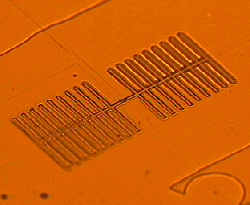Wigner Wire: Electrons Act Orderly

When electrons travel together, things usually get chaotic: They shove each other and bump against atoms as they wander haphazardly through a wire. But an experiment reported in the 22 October print issue of PRL creates the most orderly “wires” ever, by causing many electrons to travel in a fixed and rigid arrangement, like atoms in a crystal. The results could have applications in quantum computing, where organized arrays of electrons might someday be used to store and process information.
Free electrons bounce randomly through most metals and semiconductors, but under special circumstances they organize themselves into a periodic array. Theory has long predicted that this ordered state, known as a Wigner crystal, occurs at low temperatures. Experimenters have created two-dimensional versions of the crystal at the interface between two semiconductors and on the surface of liquid helium. But until recently, researchers have made few attempts to manipulate these Wigner crystals or probe their properties under controlled conditions.
Now Michael Lea of the University of London and his colleagues report a new way of controlling crystallization, which allowed them to create the first ever “Wigner wires.” The team used semiconductor etching to cut micrometer-scale channels on a gallium arsenide wafer. They filled each channel with superfluid helium and sprinkled it with free electrons from a filament. A series of electrodes above and below the wafer confined the electrons to the microchannel, where they slid around above the helium surface and formed long, narrow Wigner crystals. By oscillating the electric fields, Lea’s group vibrated these long crystals–essentially driving an AC current of crystalline electrons through the microchannel “wires.”
“The entire crystal moves as one object,” explains Lea. But it also interacts with tiny ripples on the helium surface, he adds. The crystal moves easily at or below the speed of these waves, but trying to vibrate it above the ripple velocity is somewhat akin to pushing an airplane past the sound barrier–it requires a lot of extra force. The researchers increased the strength of the AC current and found that the crystal’s outermost edges began to melt–an entirely new kind of phase transition.
Mark Dykman of Michigan State University in East Lansing is impressed with the work and says that Wigner crystals like these could someday be used for quantum computing. Each electron could hold a quantum bit, or “qubit,” of information, and the entire crystal could be used for storing data or performing operations in a future quantum computer.
–Geoff Brumfiel


